Terraforming Mars

I have owned a copy of Terraforming Mars for a while, but I was waiting to write up my thoughts on it until I had a chance to sink my teeth into the various expansions that were offered. Over the past year, I have purchased or been gifted all of the expansions and picked up some other upgrades for the game as well. This is a wonderful, complicated, time-consuming game that isn’t for everyone. A typical game can last between 1 and 3 hours, with more players increasing the overall length of play. Fair warning: the rules explanation for first time players may take upwards of an hour.
The fact that there are so many expansions can be attractive to some players, but there is a significant monetary investment to drill that deep into the game. Because each expansion is designed to be played with the base game and does not require the other expansions to play, I’ve broken down my thoughts on the base game, each of the expansions, and the entire game with all expansions in separate sections. Some of the expansions decrease the length of the game, while others increase the length.
TLDR: Overall Gameplay
I got to the end of writing all this and realized what a monstrous undertaking someone would have to go through to read all of my thoughts on this one game and all its expansion and decided to move this section to the top for convenience. Not everyone has time to read my ramblings.
Terraforming Mars (the base game) is balanced, but it suffers from what I will call the “expert bias” against new players. In short, some actions are better than others, but only after a dozen or so playthroughs does one figure out which ones are which. For example, Greenery tiles early in the game, if you can get them, are typically the strongest play someone can make because they score several times, gain bonuses from placement, and deny key locations to other players. Fundamental understanding of end-game scoring and how the global parameter tracks work comes with experience. For a group of equally experienced players, this isn’t a problem, because everyone is working from the same understanding. For groups of mixed experience, it can make new players feel left out and frustrated.
When all of the expansions are combined, many of the base game inadequacies are mitigated and multiple strategies to victory become available. As I mentioned before, there is a significant monetary investment to obtain all of the current expansions, so unless you’re a huge fan, like myself, it may not be worth the money.
For example, if you’re paying full retailer price for the base game and all expansions, you’re looking at $170 ($70 – base game + $20 Expansion 1 + $30 Expansion 2 + $20 Expansion 3 + $30 Expansion 4). You can offset this price by grabbing the game and expansions from Amazon, but you’re still looking at $136, unless one or more of the expansions goes on sale.
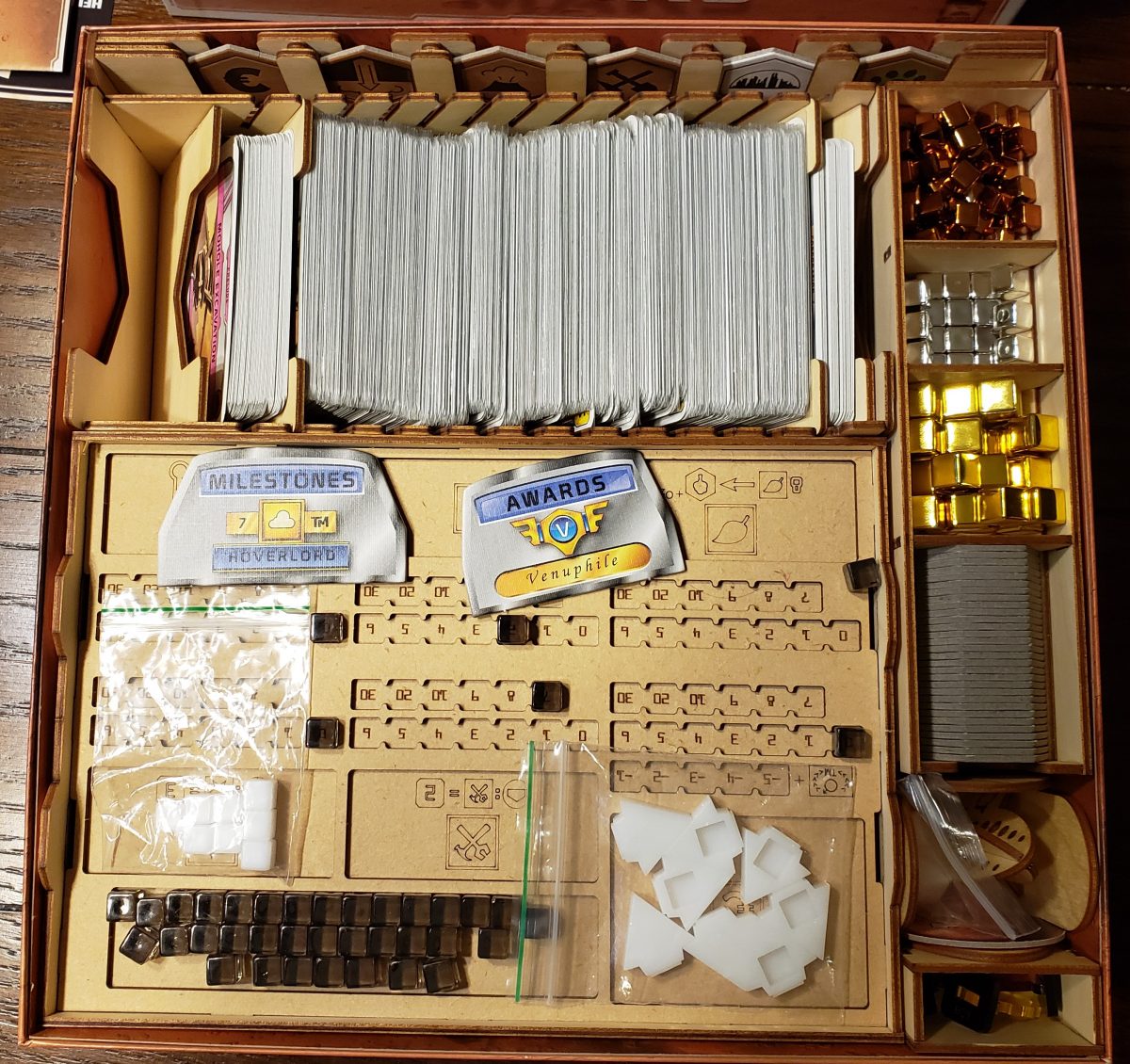
Why am I such a huge fan? Because I love the theme, the complexity, the depth, and the replayability of the game and all its expansions. And mostly, I love the ability to play this game solo.
I have played enough and know the setup well enough that I can do setup and run the entire solo challenge (terraform Mars by yourself in a set number of generations) in between 45 and 90 minutes. Because of the size of the deck, the number of corporations, and the randomness of it all, the solo mode feels like a puzzle that needs to be solved and not a game that needs to be won. I also have some serious time constraints on when I can meet up with friends for games these days, so having a board game I love available to play by myself is fantastic.
I would recommend this game to anyone who likes games that are complex and take time and anyone who likes to play their games solo from time to time. If you are interested in hearing my thoughts on each of the various components of the game, I have itemized them below as well.
Terraforming Mars – Base Game
Designed by Jacob Fryxelius and published by Stronghold Games in 2016, Terraforming Mars pits 1 to 5 players against each other as various corporations vying to contribute the most to making the red planet habitable. Steeped in science (both real and fiction), players complete projects to increase their resource production, terraforming rating (points), and the three key terraforming parameters (four if Venus Next is in play) over several “generations,” each comprised of several turns for each player. At the end of the game, once all the points are totaled, the player that contributed most (i.e., has the most points) is the winner.
Theme
The space and science theme is pervasive throughout the Projects, Corporations, game board, and mechanics. To hear it told, when Fryxelius designed the base game, he spoke with scientists and specialists on terraforming to arrive at a point in which the effort would become self-sustaining. I have no idea if this is true, but for the purposes of Terraforming Mars, those thresholds are: 14% oxygen, +8 deg. Celsius, and 9% of the land surface covered by water. A fair amount of the games rules booklet actually goes over the background and research that went into the game.
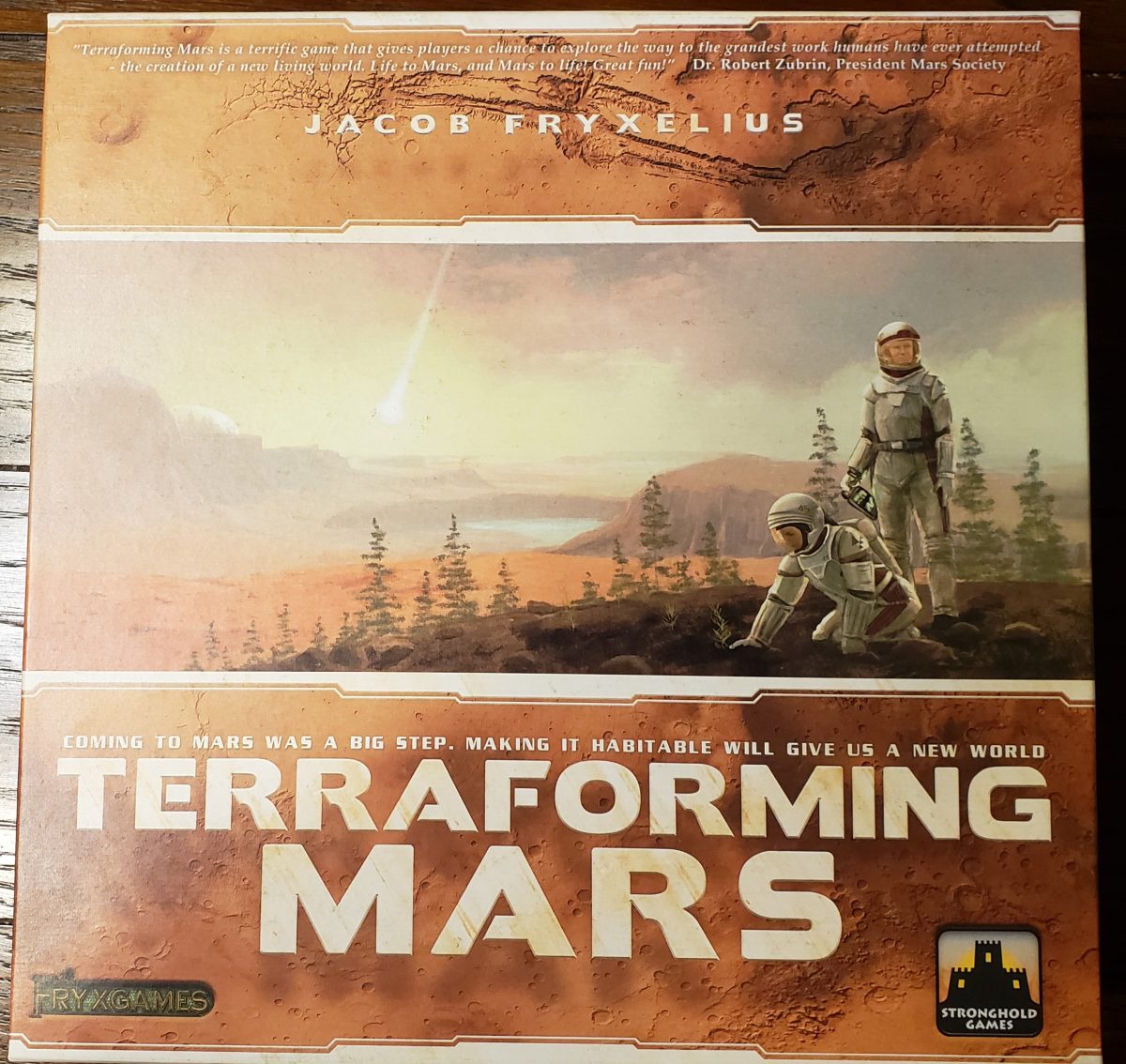
The artwork is mostly consistent, but every now and then you’ll find a Project Card that seems stylized in a different way or has a different tone. I’m not sure if there were multiple artists or not. Frankly, the art on the cards is so small, you’re not going to be spending a lot of time looking at it.
Being a huge geek, the theme of a board game is really important to me. The consistency throughout makes me excited to play. Terraforming a planet is a great idea for a board game, and I love that feeling of making a difference each generation and seeing the board evolve as you choose to invest your resources.
Quality
The components provided with the base game are okay, but feel cheap when compared to the potential price of entry. I’m sure a lot of work went into designing the game, but the suggested retail price is $70. That’s expensive for a board game. For that price, I would have expected better quality components.
There is no insert, which means that if you don’t want your components rattling around in the box, you’ll want to invest some money in an aftermarket insert like I did (more on that later). The player tokens are good quality translucent colored cubes, but the player mats are flat cardboard. A light bump can send your tokens scattering and leave you scratching your head as to what your production was and which resources were which. Again, for the price, I would have expected a player mat like the one provided in Dice Forge (a $40 game) that has cut notches for your resource production.
The resource cubes themselves look really fancy, but after a lot of play, the color chips off leaving them all the same silver. Luckily, they’re different sizes, so despite some cubes losing their luster, I haven’t gotten confused as to which is which yet. The same can be said of the global parameter tracking markers: they’re a serviceable opaque white cube. For the price of entry, I would have liked to see some better, more unique components.
The Project cards are of good quality, but there are so many of them they don’t shuffle well. Expect to spend a fair amount of time breaking the giant stack into smaller, more manageable pieces for handling.
Setup
Setup can take a while your first time out, especially if you haven’t invested in any sort of organization. Pick a spot that has lots of room for the players to expand their tableau, because this game can sprawl if you’re not careful. Also, depending on the number of players, you may want to divide the components into two sets, one for each side of the board, so players don’t have to reach across the board (and potentially bump their or their neighbor’s mat) to gather their resources.
For the most part, setup will be identical whether you’re playing with an expansion or not. I’ll cover the base game setup here, and expansion-specific setup requirements in those sections below.
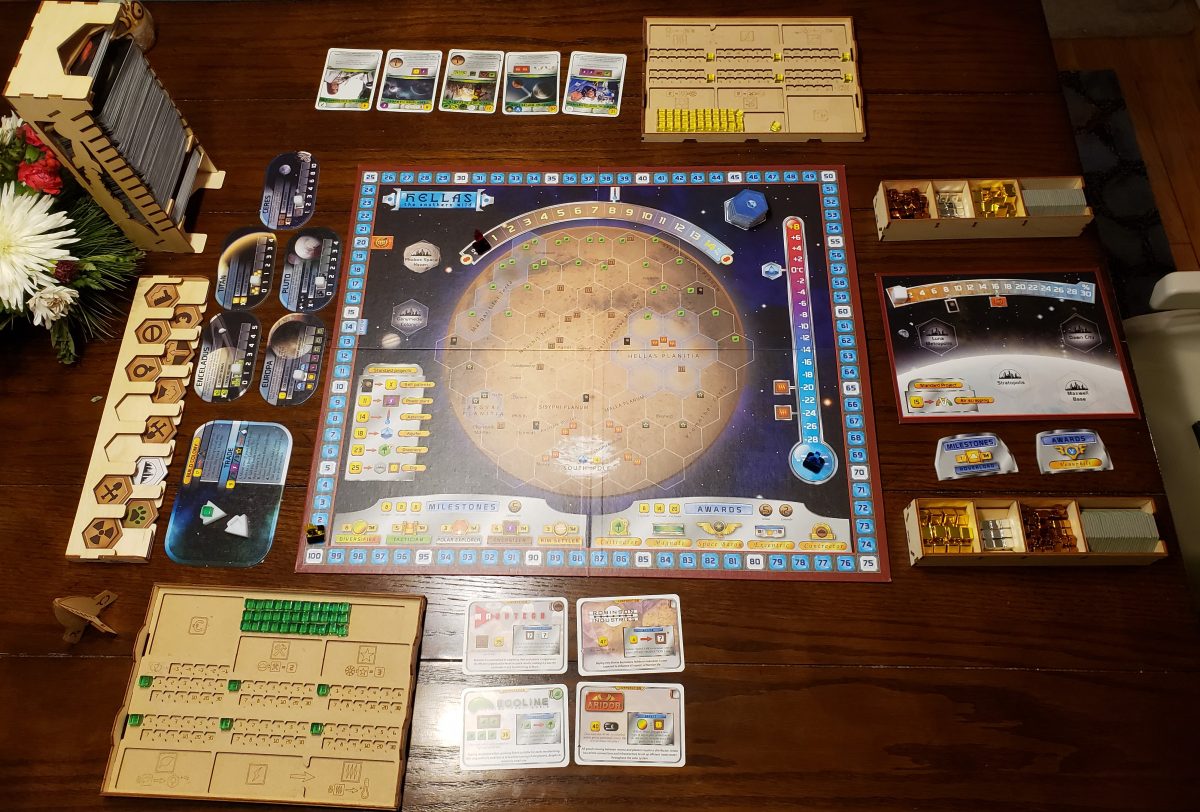
Select the board you’re playing on (assuming you own the Elysium & Hellas Basin expansion, otherwise, you only have the original map to choose from) and lay it out on the table. Place a global parameter tracking token on the lowest position on each of the oxygen, temperature, and generation tracks (the generation track is the score track around the outside of the board). Place the 9 Ocean tiles in a pile on the indicated position on the board. Each player will select one of their player tokens (colored translucent cubes) and place it at 20 on the score track around the outside of the board (same track as the generation marker is on). While playing the game, this outside track will function as the generation counter and the Terraforming Rating.
Shuffle the Project card deck. If any of the players wishes to use one of the Corporate Era corporations (advanced rules), make sure these Project cards are included in the deck. If no one is playing one of the advanced Corporations, remove these cards from the deck; they won’t be used. I mentioned earlier that this deck is massive, so shuffling can take a while. A base game deck using only beginner cards is smaller, but is still large enough that it will likely need to be divided into 3 sections for a proper shuffle.
If the advanced corporations are to be used, shuffle them as well. Set out the resources (copper, silver, and gold cubes) in easily accessible areas. Divide the double-sided City/Greenery tiles into several stacks and lay them out around the board.
Players may choose to use a Beginner Corporation if it is their first time playing Terraforming Mars, and they should do so. Trust me. Those players then set the production of each of their resources–MegaCredits (cash), Steel, Titanium, Plants, Energy, and Heat–to 1. They then draw 10 Project cards from the deck as their starting hand, and take 42 MegaCredits. They do not pay for their starting cards.
Those that elect to play the more advanced Corporate Era rules will receive two random corporations. These are secret until the start of the game. Take a look at them, but don’t do anything with them yet. These players also receive 10 Project cards to start; however, they then need to review these cards and select which Projects they wish to keep and which corporation they will use. Once selections are made, players take the actions listed on the corporation, receive their starting cash, and pay for the Projects they keep at a rate of 3 MegaCredits each. A common mistake in Terraforming Mars is to select your corporation without reviewing your starting cards yet and find yourself lacking in synergy, or to keep all your initial Project cards and find yourself cash-poor and unable to play anything.
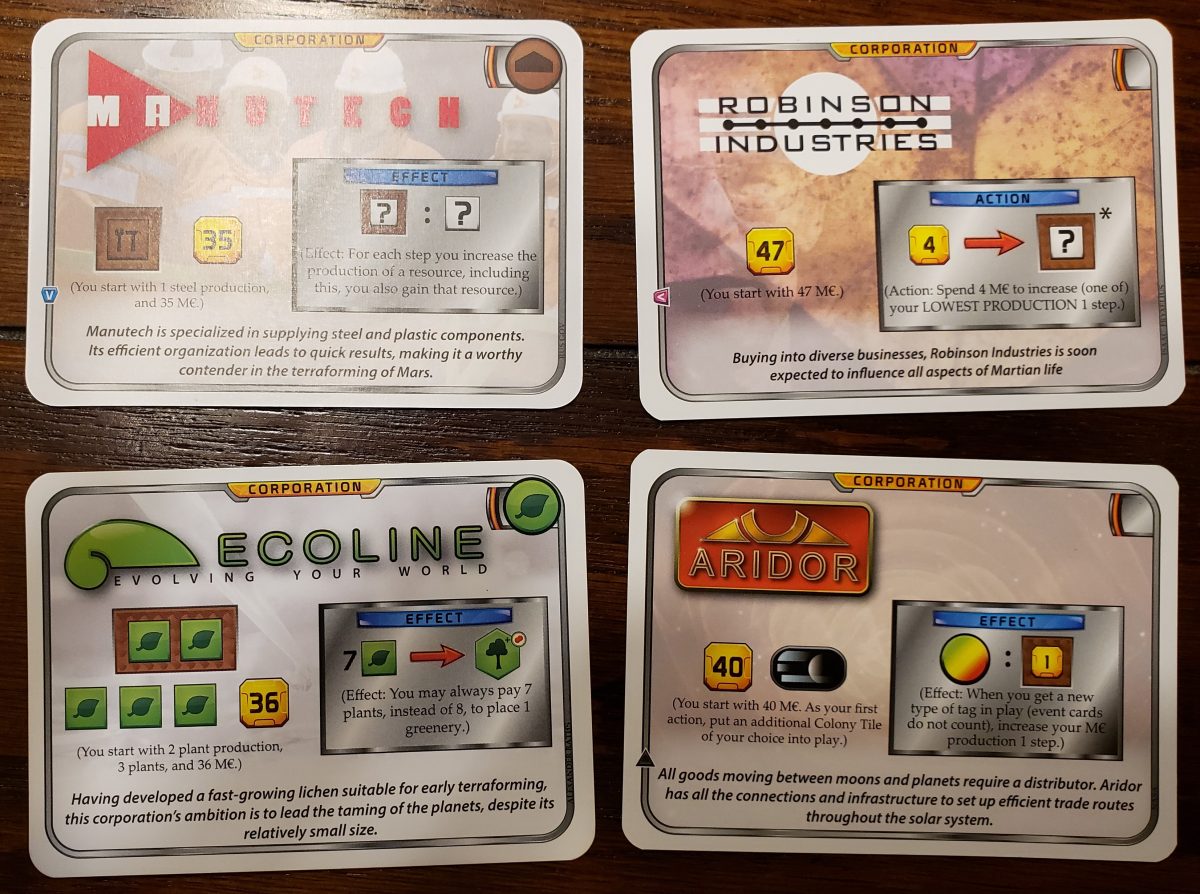
Once everyone is happy with their starting cards and has paid to retain those Projects, as applicable, pick a starting player. This person will receive the First Player token. You’re ready to start your first generation.
Rules
Terraforming Mars plays out over multiple generations, each of which comprised of many turns. In order to prevent any single player from gaining incredible momentum from chaining projects, each player is restricted to completing a maximum of two actions before play passes to the next player. Don’t worry, you’ll get as many actions as you can afford in each generation, but you need to give the other players an opportunity to act as well.
Each generation is composed of four phases (five, if playing the Venus Next, Prelude, or Colonies expansions, as discussed in those sections).
- Player Order shifts one step clockwise. For obvious reasons, this doesn’t occur during the first generation.
- Research occurs next. Each player is dealt 4 cards. They then choose which cards to purchase for 3 MegaCredits and add to their hand (no hand size restrictions). They may also choose not to purchase any if they want to save some money for actions during the generation. Again, this does not occur during the first generation.
- Actions are played next. As described above, each player has a maximum of two actions they can take before play passes to the next person. If you pass without taking any actions, you are out for the rest of the generation and cannot play any additional actions during this generation. Completing a single action before turning play over to the next person is okay, though, and you can still take additional actions once it is your turn again.
- Production occurs for all players. You earn all resources equal to your production rating for that resource, as tracked by the tokens on your player mat, with the exception of MegaCredits. Your MegaCredit income is equal to your production rating on your mat plus your current Terraforming Rating (tracked on the board).
Actions break out into several types: Standard Projects, Project cards, Special actions, claim a Milestone or Award, convert Plants into Greenery tiles, or convert Heat into Temperature. There’s a lot going on here, so let’s dig a little deeper.
The following Standard Projects are available to all players on their turn and do not require a card to perform:
- Sell Patents – sell Project cards
- Power Plant – increase your Energy production by 1
- Asteroid – increase the global Temperature by 1
- Aquifer – place 1 Ocean tile
- Greenery – place 1 Greenery tile
- City – place 1 City tile, increase your MegaCredit production by 1
Project cards come in three types: Automated (green), Active (blue), and Event (red). All cards, regardless of their type, have some requirement in order to play. The majority of the basic Project cards included for the Beginner game only require MegaCredits to play. Corporate Era and other expansion Projects have further restrictions, such as a maximum or minimum oxygen content, having some number of other cards with a specific Tag on them, and so on. Project cards also each come with a Tag (upper right hand corner), a description of what they do, and some sort of flavor text.
All Project cards are played on the Tableau in front of their owner, with the Tags visible. This is so the player knows which Tags they have in play in order to meet future requirements. Automated Projects are typically stacked so that only their name and Tags are visible, as each player will be playing between 12 and 24 of these each turn. Stacking them reduces the sprawl.

Active Projects, on the other hand, tend to get played on the Tableau spread out, so their owners can see their text. This is because they have the capability of being used as Special Actions each generation for that player. Taking these Special Actions still require the player to use one of their two actions in that turn.
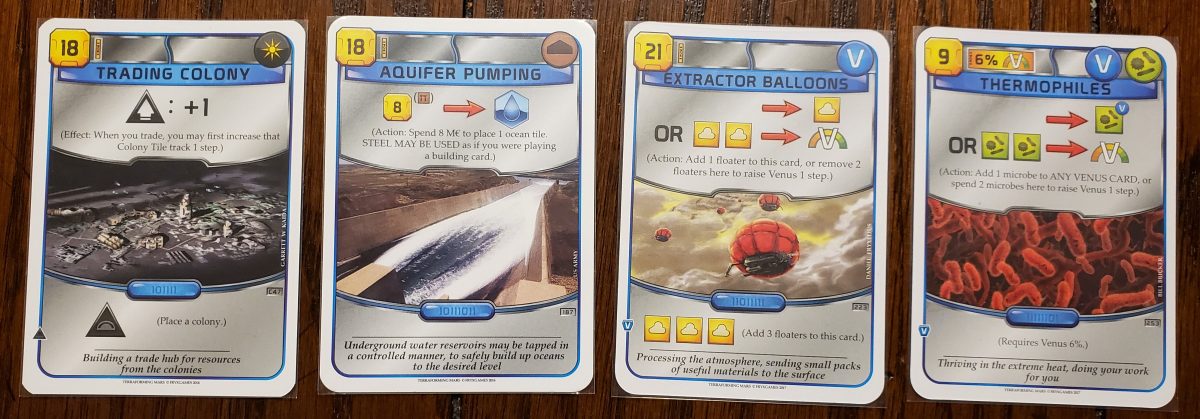
Event cards are “instant” Projects that do not linger beyond the turn they are played on; however, they do often carry powerful bonuses and are worth evaluating. Their Tags will count towards meeting a requirement for another Project card, but only on that same turn (not to be confused with the same generation).

At some point during the game, players may meet the requirements to lock in a Milestone. Milestones come in a variety of flavors, but they all boil down to a single concept: be the first to do that thing, then spend 8 MegaCredits to lock in those points. A maximum of 3 Milestones can be selected each game and the person that pays the cost and spends the action to lock themselves in as the winner gets those points. Therefore, it doesn’t matter that you were the first to 3 Greenery tiles on the board if you didn’t spend the money to lock in that Milestone in your name and another player gets there first.

The same is true for Awards, although their scoring does not happen until the end of the game, and the player who funds them is not guaranteed to win. Additionally, the cost of Awards increases as more are funded, unlike Milestones, which always cost 8 MegaCredits. Essentially, Awards that are locked in are then evaluated at the end of the game and the player that best meets that criteria gets 5 points, with the runner-up getting 2 points. Although you are the one who selects an Award, if you’re not careful, another player may snipe the win away from you at the last moment.

Project cards aren’t the only way to influence the board, the global parameters, or your income. Every corporation has the ability to convert Plants to a Greenery tile at a rate of 8:1. Greenery tiles, when placed, increase the global Oxygen by 1 tick (1%). Likewise, every corporation can turn in 8 Heat resources to increase the global Temperature by 1 tick (2 deg. Celsius). Each time a player moves a global parameter, they also increase their Terraforming Rating by 1 for each parameter moved.

Tile placement rules on the map are as follows: Greenery tiles must be placed next to another of your tiles, unless a Project card specifically tells you to place a Greenery tile somewhere else. Cities do not need to be placed next to your own Greenery tiles, but cannot be placed adjacent to another City (again, unless a Project says otherwise). Special tiles need to be placed according to the restrictions on the Project card that allows their usage.

Lastly, all resources persist from one generation to the next with the exception of Energy. All remaining Energy is converted to Heat at the end of a generation, during the Production phase.
Gameplay
Each generation goes like this: player order shifts; new cards are handed out; new cards are retained; money is paid to the bank for the retained Project cards; players take their actions until no one has any money left or possible actions to do; production occurs; next generation.
While this description is overly simplistic, it can be very easy to get bogged down in details in Terraforming Mars. Each turn is about optimizing resources, weighing cost investment and return, and maximizing your number of actions. The hardest part of the game is learning the cards; since they are all unique, it can take several playthroughs to see a repeat card in a game. The Project cards look complicated, but if you look closely, they tell you exactly what they do and what their restrictions are.
While not as important for a Beginner game, Tags become incredibly important when using the advanced rules. This is because Tags may allow you to chain your production gains by specializing (e.g., increase your Titanium production by 1 for every Jovian Tag you have in play), gain access to more powerful cards (e.g., requires 3 Earth Tags to play), or to offset costs (e.g., Steel can be used to pay for Project cards with a brown building token at a rate of 1 Steel = 2 MegaCredits).
Board control seems simple, but everyone is fighting over the same space and wanting to deny each other board score. City placement, specifically, can get cutthroat, as Cities will score for the owning player for the Greenery around it regardless of who owns that Greenery.
Terraforming Mars offers several paths to victory. First, players can focus on the map, Greenery and City tiles, and clever placement. Another option is to focus on high point value Project cards. Still another strategy is to find the Active cards that grant points for various conditions, and focus on building their score that way. The Milestones and Awards, while nice chunks of points, are really just a way for players to convert excess cash at the middle/end of the game into the potential for points.
Victory Conditions
Once all global parameters have reached maximum (14% oxygen, +8 deg. Celsius, and 9 Ocean tiles deployed), the game will end when that generation is complete. Players should complete Phase 4 (Production) as normal and there will be one additional opportunity to convert Plants to Greenery tiles. Once all Plants have been converted, commence scoring.
Greenery tiles are each worth 1 point. Cities are worth 0 points by themselves, but score 1 point for each Greenery tile adjacent to them (maximum of 6 points). Greenery adjacent to a City will score multiple times. Sum the total point value off of the cards you played. The total from Greenery, Cities, and cards will be added to your Terraforming Rating. That is your total score for the game. Note that MegaCredits serve to break ties, so it is always worthwhile to gain your income during the final Production phase and to sell any remaining unplayed Projects in your hand before the end of the game.

Note: none of the expansions change the victory conditions or scoring in any way.
Opinion
I love this game, although the base game gets boring after a while. It becomes clear after a number of playthroughs that there are a few actions and Projects that are simply better than the others. This is mitigated somewhat in a larger game (4 or 5 players) because of the randomness of the Research phase and the board control, but those games are difficult to table, because of the length. If you’re interested in the theme and like the concepts, I would definitely check it out.
Terraforming Mars retails for $69.95 from Stronghold Games directly, but is typically $59.95 from Amazon and I have seen it as low as $40 before during holiday sales. I received my copy as a Christmas gift, but I think $40 to $45 is a good price for the base game, so if it drops that low and you’re interested, you should not hesitate to grab it.
For anyone who wants to dip their toe in the water without the full price of admission, PlayDek has created a digital version for Terraforming Mars, which is distributed through Steam for $25.00. Fair warning, there are currently no expansions available for the digital version so, while they may be on the way, anyone who falls in love with the game the way I did may have to wait for them to become available, or purchase the board game separate. I should also point out that some users have experienced bugs that have ruined the digital experience for them, so purchase at your own risk.
Elysium & Hellas Basin – Expansion 1
The first expansion to Terraforming Mars was a new board to supplement the one provided in the base game. This new board is double-sided and seeks to remedy a few key complaints about the original board. First, while the Milestone and Award system was designed to be flexible over dozens of play-throughs, having only 5 of each (even though a maximum of 3 each will be selected each game) began to feel old pretty fast. Second, it became clear after launch that players found ways to optimize their build strategy based on physical location on the board–some locations are simply better than others.
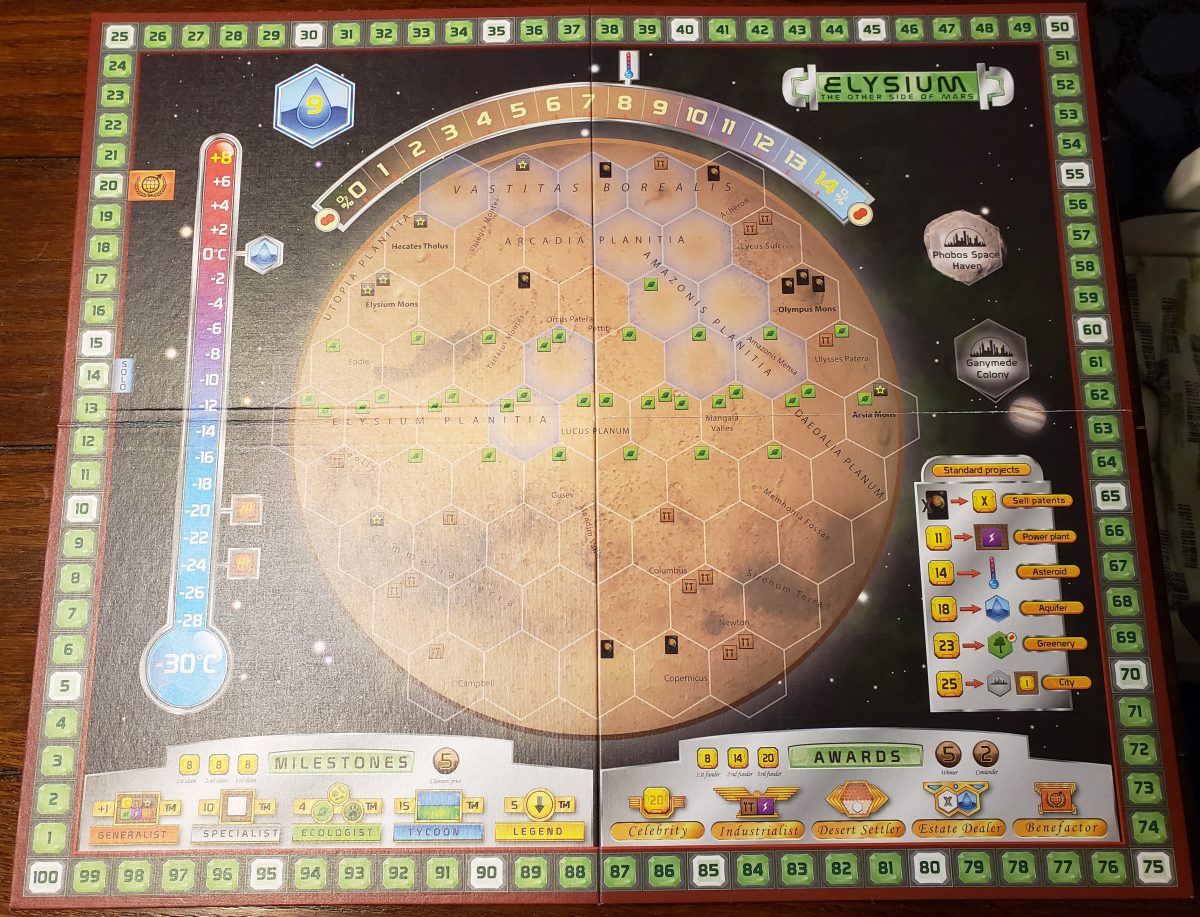
Elysium is the green side of the new board and overlaps the original board a little bit, but does not provide any new mechanics or placement bonuses over the original.
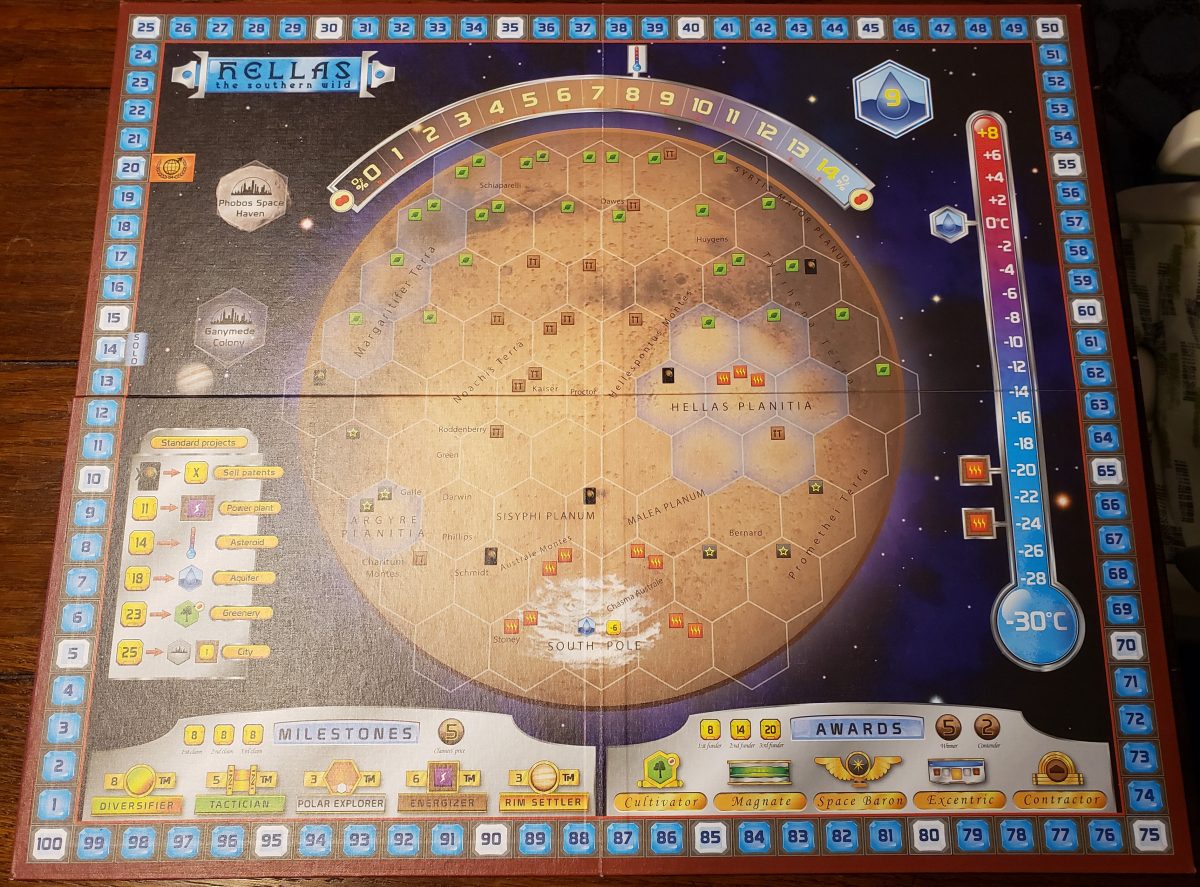
Both sides of the new board are, like the original board, based on the factual features of the red planet. Each board has unique Milestones and Awards.
Rules
The first expansion does not alter the fundamental rules of Terraforming Mars, but because some of the key features of the original board are not present on these new maps, some Projects from the original game need to be modified. For example, the Hellas Basin map lacks volcanos and the Noctis region; therefore, the placement restrictions from those Projects go away. The boards are packaged with a 1-page sheet that describes the specific placement restriction alterations and specifies exactly how each map’s Milestones and Awards function.
Gameplay
Again, this expansion does not fundamentally alter the game. The addition of new boards means new potential strategies, which is always a good thing, but not a requirement to enjoy the base game.
n
Opinion
The Elysium & Hellas Basin expansion board is certainly not necessary to enjoy the game; however, it is a cheap/easy way to mitigate the “expert bias” I described above. Having 3 different boards to play on is a nice change, but the expansion board may not fit in the box very well, depending on what other expansions or upgrades you’ve purchased and how you have the game organized.
The expansion board retails for $19.95 from Stronghold games, but Amazon typically has it for around $13 or $14 dollars and it doesn’t seem to ever go on sale. If you’re playing a lot of Terraforming Mars and are bored with the base game map, it might be worth it.
Venus Next – Expansion 2
The second expansion, the designer was hoping to increase the variety of Project cards available, new corporations, a new global parameter, a new Award, a new Milestone, and a new mechanic: Floaters.
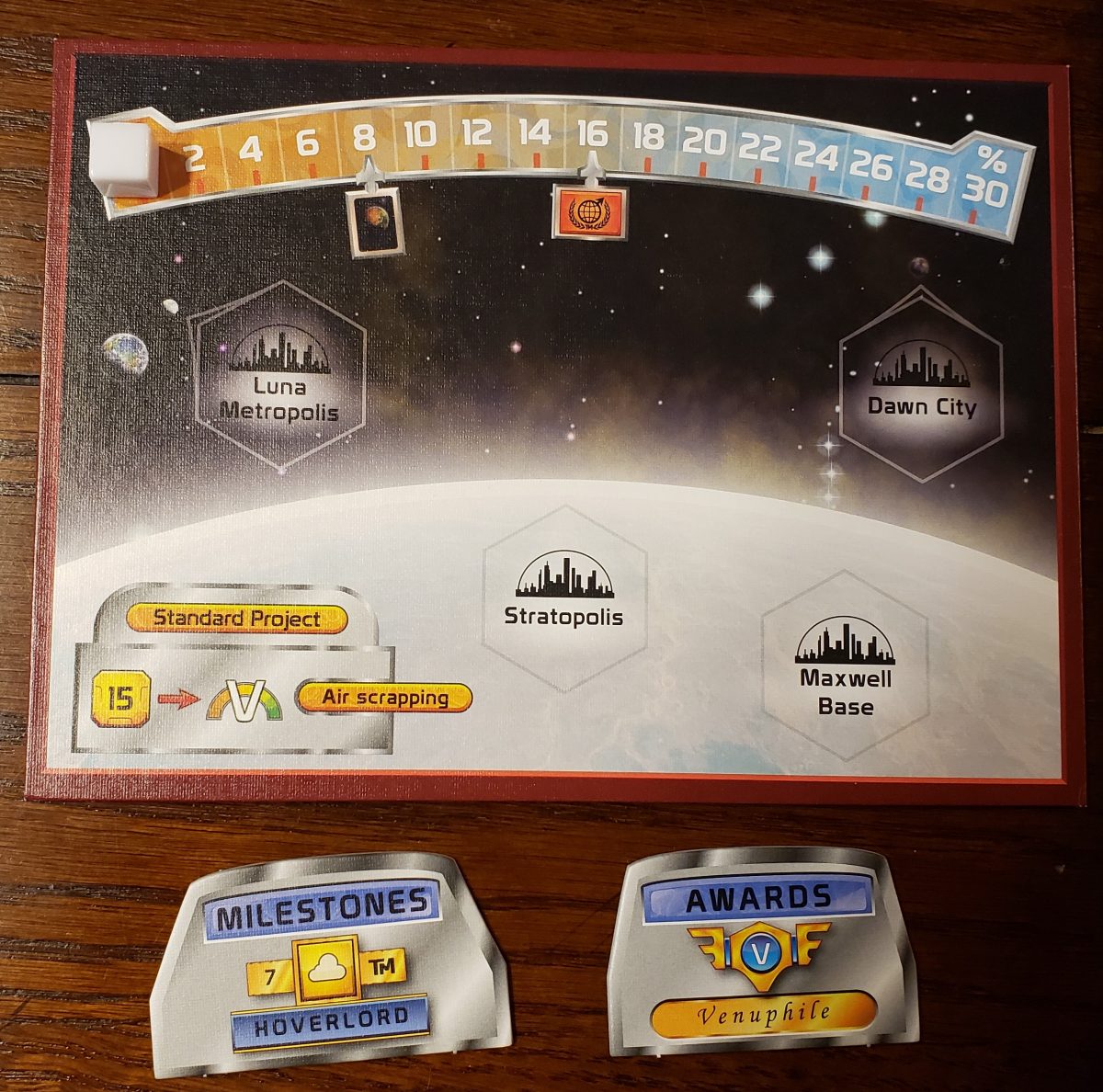
Setup
Place the Venus scale next to the selected map of Mars and put one of the global parameter tokens on the lowest end of the scale. Shuffle the Venus Next Project cards into the Project deck. Shuffle the new corporations into the corporation deck. All other setup is the same.
Rules
The new global parameter (the Venus scale) works the same as the other global parameters, but is not considered an end-game condition (i.e., it does not need to be maxed out in order to end the game). A new Standard Project is introduced that allows players to increase the Venus scale by 1 for 15 MegaCredits.
They also introduce a new type of token called a Floater. Floaters can be placed on certain Venus Next Project cards for points at the end of the game or to allow the use a Special Action (e.g., place one floater token on this card OR remove two floater tokens from this card to increase the Venus scale).
Venus Next also adds a Phase 5 to each generation called “The Solar Phase,” as a direct response to the length of the game. The current First Player selects one of the global parameters and increases it by 1 for free. They are acting on behalf of the World Government Terraforming effort and, therefore, do not get the benefits of that increase.
Gameplay
Venus Next attempts to give players more options while also giving them more control over the pace of the game. The Venus Scale allows players to slow the game down (players can invest in that parameter instead of the 3 that trigger end of game). The Solar Phase allows players to speed up the pace (by increasing the 3 end-of-game global parameters) and it mostly accomplishes this goal, except many people do not even appear to realize the Solar Phase is an option.
Venus Next mostly falls flat as a sole expansion (without any of the other expansions in play). I have played Terraforming Mars dozens of times and have only had a group want to play with the Venus Next expansion once, and that was right after launch. Given that it mainly adds another 30 to 45 minutes to a game that could already be upwards of 2 hours, I don’t blame them. The Floater mechanic doesn’t add much new to the game without the benefit of the Colonies expansion (more on that later).
Opinion
Venus Next is a half-baked idea that doesn’t shine until the Colonies expansion completes what it was trying to accomplish: give players more Project options for earning points and access to actions not on the board. Because of the randomness of the Project deck, players can often find themselves bereft of Projects that work well with their corporation. Having access to more source of points (other than increased Terraforming Rating and board presence) is a great idea, but the new Project cards that take advantage of this mechanic are pretty rare.
If you’re going to pick up Venus Next, I strongly recommend picking up Colonies at the same time, as many of the Colonies expansion Projects also utilize Floaters, increasing the chances you’ll actually be able to use those new cards effectively instead of just trashing them in the Research phase. The additional income players earn from trading with the Colony tiles (again, more on this later) offsets the potential game length increase by giving them access to more resources each generation, which means more turns between Production and a faster overall game.
Venus Next does occasionally go on sale. I picked up my copy for $15 from Amazon (suggested retail is $30 from the publisher), but I do recommend playing this expansion without Colonies to mitigate its weaknesses.
Prelude – Expansion 3
The third expansion does a lot to correct the lengthening of the game by Venus Next. Prelude adds a number of new Project cards, new corporations, and the new Prelude deck.
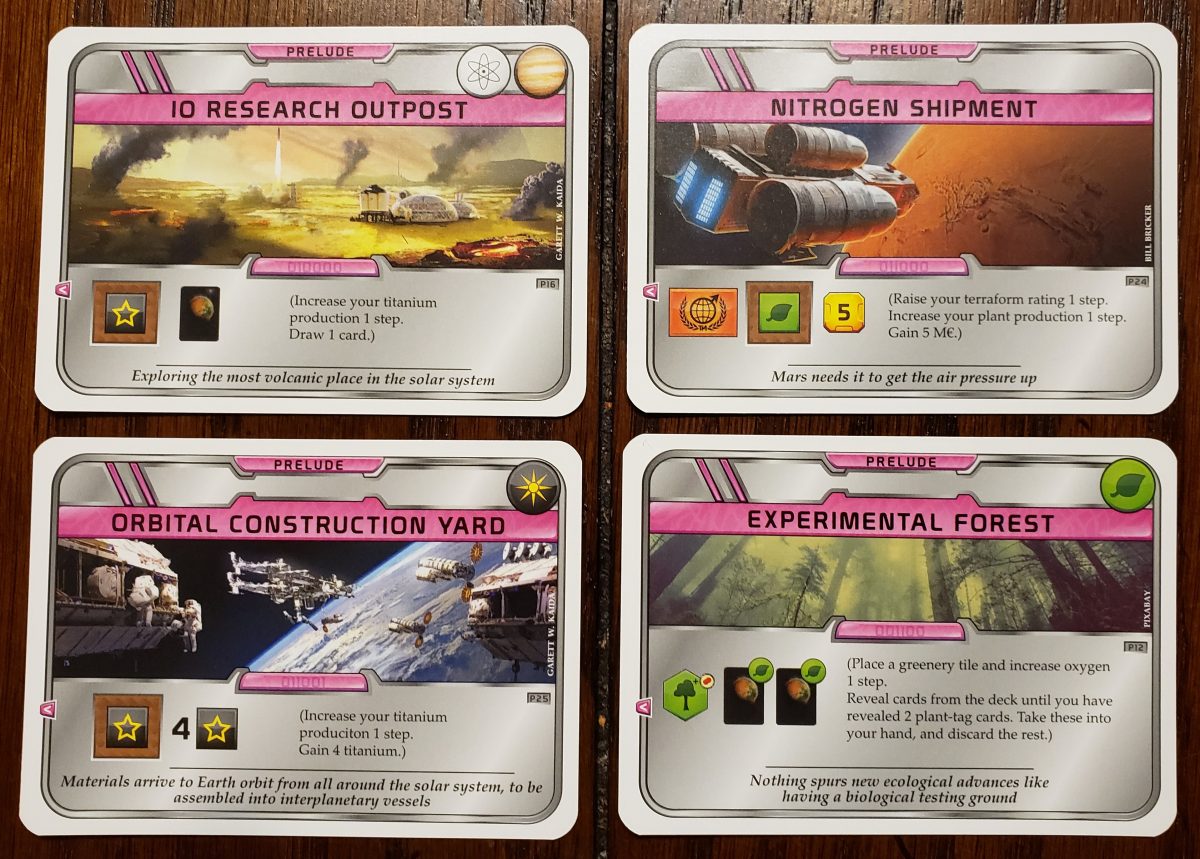
Setup
Shuffle the new Project cards into the Project deck. Shuffle the new corporations into the corporation deck. Shuffle the Prelude cards and deal 4 to each player, face-down, during setup.
Rules
Players get to look at their 4 Prelude cards along with their random corporations and the 10 starting cards. Each Prelude card grants a massive benefit to the player and they are allowed to pick two of these cards to play as their first 2 actions of the game. They do not cost anything and remain in play (much like the green Automated Project cards), as they typically also have Tags on them as well. After all Prelude cards are played, the game continues as normal with no other alternations.
Note, you cannot choose to play 1 Prelude card (i.e., 1 action) and then pass; you have to play both Prelude cards as your first turn. This is the only time you’re restricted to playing 2 actions on your turn.
Gameplay
Prelude adds to the game in a way that none of the other expansions do. It allows players to shave 30 to 45 minutes off of the game by getting a head start that is catered specifically to the cards they were dealt and their selected corporation. Every group I have played with has treated Prelude as a “must-have” expansion in play, when available.
Opinion
This is probably the only necessary expansion of the lot. It’s almost a must-have in order to make the game palatable for the less patient crowd. It is also one of the cheaper expansions at $20 base price, and is regularly $12 to $15 on Amazon. In my opinion, if you own Terraforming Mars and enjoy it, Prelude will make it that much better.
Colonies – Expansion 4
Released in late 2018, Colonies expands upon what Venus Next started by giving more paths to resources and income that were not otherwise available to players. Instead of adding more head-start mechanics, like Prelude, they added to the mid- and late-game through the addition of Colonies.
As with Venus Next and Prelude, the expansion also comes with a healthy share of new Project cards, new corporations, and new mechanics.

Setup
Place the Trade Fleet board next to the selected map of Mars. Each player should place one of their colored cubes into a Trade Fleet token and place it on the Trade Fleet board. Shuffle the Colony tiles and draw a number equal to the number of players plus 2 (use 5 for a two player game) and place them next to the board. Place one of the provided tokens (opaque white cubes equal in size to the colored player tokens) on the highlighted space of each Colony (typically the second spot).
Shuffle the new Project cards into the Project deck. Shuffle the new corporations into the corporation deck.
Rules
Players now have access to a new Standard Project, “Build a Colony,” for 17 MegaCredits. Players will put one of their colored player markers on the lowest space track on the Colony of their choice and claim the reward in that square (e.g., increase Energy production by 1).
Players cannot place more than 1 of their own tokens on a Colony tile (unless allowed by a Project). Colony tiles are restricted to 3 player tokens per tile.
A new action, “trade with a colony,” is now available to all players. When taking this action, they pay the cost (9 MegaCredits, 3 Energy, or 3 Titaniam–no substitutions or splitting!) and move their Trade Fleet to the Colony of their choice. Once their, they gain the amount of resource indicated by the white production token, then move that token to the lowest free space available. Players with a Colony there also get a bonus.
During Phase 5, “The Solar Phase,” and after the World Government Terraforming effort (assuming you’re playing with the Venus Next expansion), you will move the white production token on each Colony tile up by 1.
Gameplay
Colonies does a great deal to shore up the mid- and late-game of Terraforming Mars by offering alternatives to gaining resources other than waiting another generation or investing into resource production or tile placement on the map that you wouldn’t otherwise have looked at.
Want Steel, but don’t want to battle for it on the map and haven’t gotten any good Project cards to increase your production? It might be time to build a Colony on Ceres, or just ship a Trade Fleet out there to gather up all that Steel that’s been accumulating. Whatever you’re going to do, better do it fast, because if you don’t, your opponent might get there first.
I haven’t yet played Colonies in a competitive game (only Solo), but I can imagine that after each generation, there is a mad rush to be the first to get their trade fleet to the ideal Colony. And some of them are pretty juicy!
For example, Pluto lets you draw cards. Titan lets you add Floaters to the cards of your choice (assuming they can accept them). Miranda gives you Animal tokens to the cards of your choice.
Colonies also expands upon the Floater mechanic and makes it more viable. You don’t need Venus Next to play, but the Projects in Colonies strengthen and synergize with the ones from Venus Next in a way that makes both expansions better together than they would be separate.
The ability to gain access to these resources, especially tokens that typically can only be accumulated at a rate of one per generation, make many of those cards more viable choices in the mid- and late-game. With the base Terraforming Mars, many of the animal and bird cards are overlooked because they can’t be played until Oxygen is almost maxed out. They grant decent points, but usually can’t be played until there’s not time to accumulate the tokens that would make them reliable to offset the cost you would invest into them. Trading with Miranda would allow you to add up to 3 animal tokens in a single generation, which could be worth up to 3 points at the end of the game from a single action.
Opinion
While not as necessary as the Prelude expansion, I have been really enjoying the Colonies expansion quite a bit. This one is worth adding to the collection if you find the mid- and late-game lacking in your own playthroughs, or have a group that is looking for more things to do than just play yet another Project card.
As the newest expansion, Colonies is most likely going to be full priced at $30 from most sources, but keep an eye on Amazon. In my experience, the price of the Terraforming Mars expansions drops by about 25% after 6 months.
Game Upgrades
As if this game wasn’t expensive enough, there are a number of upgrades that can be purchased. None of them are strictly necessary, but a few of them will make the game better. In my opinion, at least one of them should have been included in the base game.
Game Trays
The player mats provided in the base game and used for all expansions are flat paper-board. Sure, they’re pretty and they do the job (barely), but there are options out there that are much better than what is offered in the game.
Most of my friends that also own Terraforming Mars opted for some sort of Clear Acrylic Overlay, which fits around the original player mat and gives them rigidity while providing slots with which to keep track of resources and production. Early on, lots of Etsy businesses were providing these for $5 or $6 per overlay, or a total of $25 to $30 for all five players.
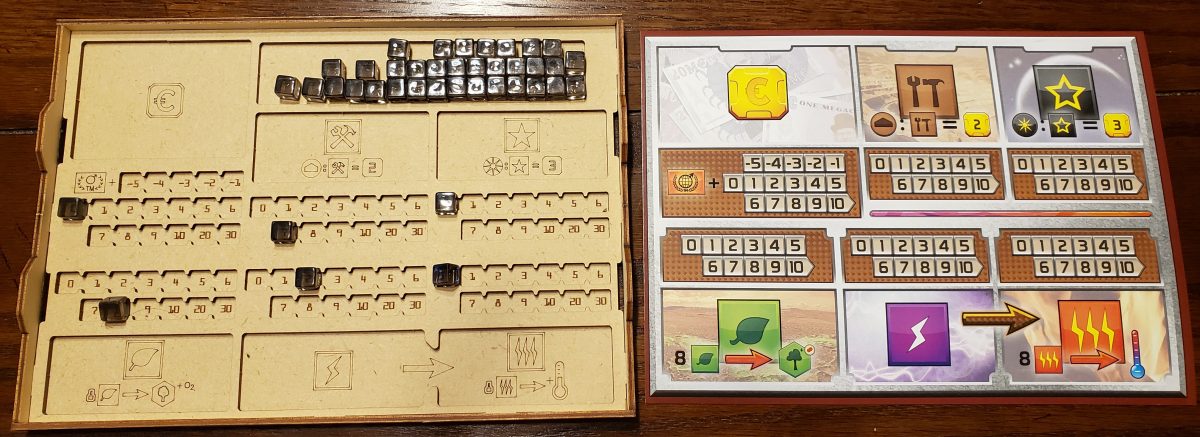
By the time I received my copy of the game, the market for most Etsy businesses were no longer offering these, or were offering for $10 per mat ($50 for the whole set)! So, I opted to grab the Broken Token’s Box Organizer for $50 from Amazon, which had custom laser-cut trays that served the same purpose as the overlays, and also provided new global parameter tokens, trays for all the resources and tiles, and a card tower. It comes in sheets that have to be broken apart and glued together, but I enjoy projects like that. I also found it worth it to put a light polyethylene coat over everything to give it some water resistance in case of a drink spill.
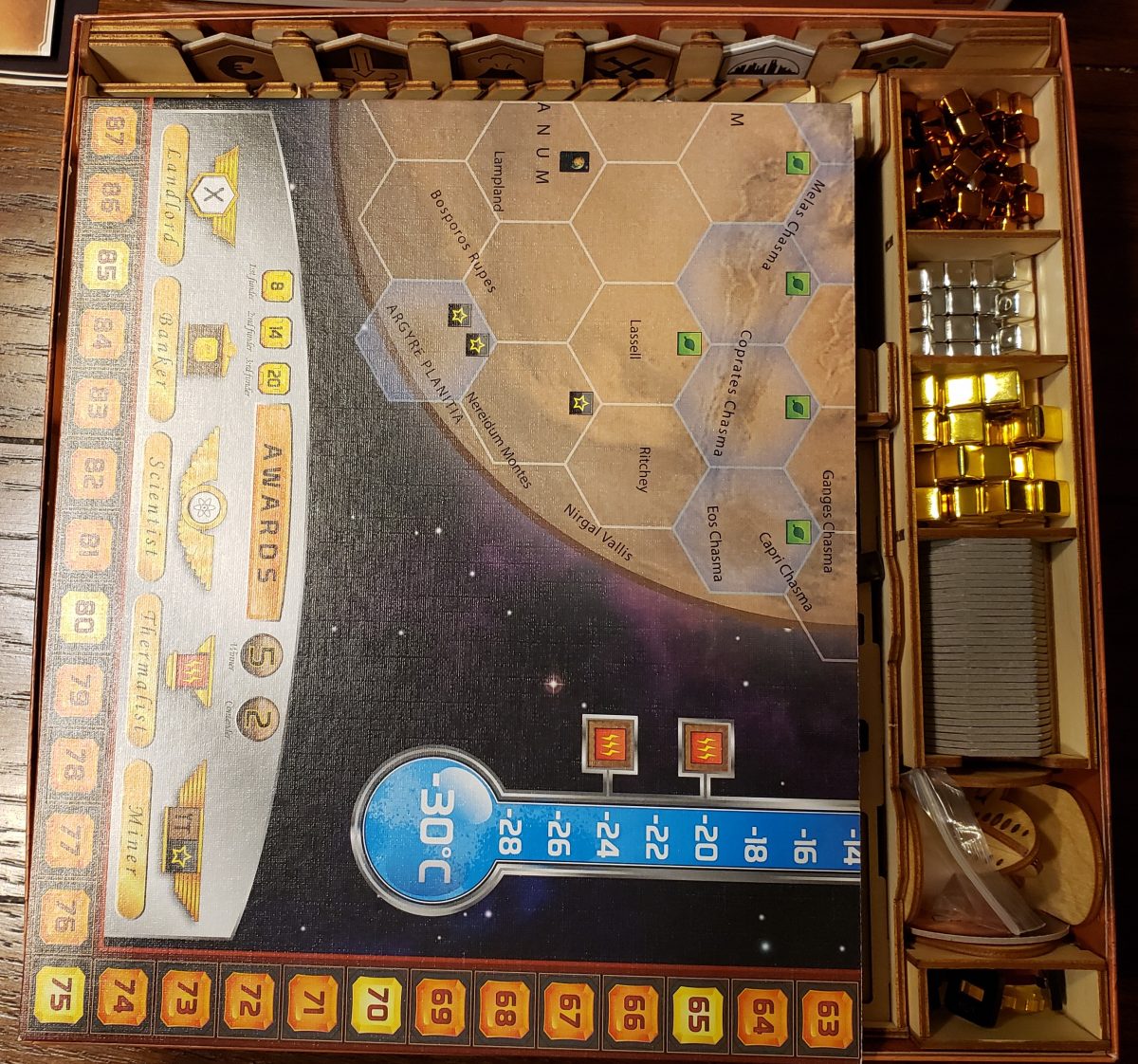
Card Sleeves
I don’t normally sleeve my cards, but the deck for Terraforming Mars was so large, I couldn’t shuffle it. I opted for some Perfect Fit (64mm x 88 mm) sleeves, and I’ve needed about 350 of them. Now I can just seat them next to each other and wiggle them around about and get an almost perfect shuffle without dividing into 30 piles. If you are like me and can’t shuffle to save your life, you can snag them on Amazon for about $10 per 300, depending on the brand of your preference. If you can shuffle pretty well, then don’t bother with the unnecessary expense.
These also take up a fair amount of space in the Broken Token card deck holder. I doubt I will be able to fit any further expansion projects without unsleeving all the cards, so that is something to keep in mind as well.
Solo Play
The rules of solo play are a bit different, depending on which expansions you’re playing with. The base game requires you to max all 3 global parameters in 14 generations. Venus Next adds a 4th parameter to max in the same 14 generations, but the Solar Phase also allows you to increase 1 of your choice at the end of each turn, so it should take the same amount of time. Prelude reduces your time limit to 12 generations, but allows you to set a goal of 63 Terraforming Rating instead of maxing global parameters if you so choose. Finally, playing with Colonies requires you to reduce your income production to -2 MegaCredits at the start of the game.
Therefore, if you want a challenge, you play all 4 expansions, which means you get 12 generations to max all 4 parameters and you start at a -2 MegaCredit disadvantage at the beginning of the game.
As I mentioned above, playing solo is more like solving a puzzle than playing a game. Because you’re the only player, you do not need to worry about the 2 actions per turn limitation (i.e., you play your 2 actions and pass to the next player, who is you!). There are no other rules differences.
Gameplay-wise, you will spend your time focusing on anything and everything that can help you improve the global parameters and terraforming rating. This means you’ll be ignoring any cards that provide points at the end of the game, for the most part. Once you’re comfortable in your ability to complete the challenge, then you can spend some time accumulating points to see if you can beat your own best score.
